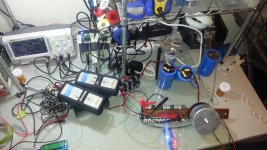The Vds overshoot that occurs is caused by the parasitic inductance in the layout and is independent of the load inductance. It is difficult to mitigate this in an already existing design. The type of controllers you are working with are basically toy level, but they function.
The larges issue is that that the DC bus is not overlapped which is required for high current. Details such as this become extremely important as current levels increase. The easiest way to fix problems is to design them out. Adding on additional MOSFETs is asking for issues. If you want to design your own power stage and trigger off the controller's signals using your own gate drive, that would be the best way to go about what you are suggesting.
The gate drive on most of the ebike controllers are simple totem pole designs with inadequate current supply to the gate which leads to very long transition times on/off. Adding more devices will slow this down even more (which helps turn off overshoot).
MOSFETs don't share current in a linear array very well either.
Here is an example I have from the other day showing 11 parallel TO-247 devices which were Miller Plateau matched by hand to minimize switch latency issues.
View attachment 1
As you can see, there is a large current difference between the 1st and 11th device (purple and blue traces). The ratio remains fixed even as the current varies. I think this was ~600A into a 25uH load coil. The upper traces show the Vgs and Vds. Yellow is Vgs showing the voltage transitioning from -8V to +15V. Cyan is Vds which shows about 40V of overshoot at turn off which has a Vds transition time < 300ns (i think I still have gate resistors on here for fast switching). The slower you turn off, the less pronounced the Vds overshoot is due to lower dI/dt on the freewheeling devices' body diode reverse recovery. The Vds overshoot period is equal to the reverse recovery time of the freewheeling diode. The magnitude and length of the overshoot is directly proportional to switching speed and how much parasitic layout inductance your design has.

Now, in order to really understand all of this I had to invest in some specialized equipment and play around. The type of research / design work I'm doing is not possible without the right test gear. If you have access to differential probes (pretty much a must have) and rogowski coils (super nice to have, but not required), then power electronics is a very fun field. It's multi disciplinary though. I suggest learning the meanings of Maxwell's equations and the all the physics at play.
If you look at threads I've started over the years you will find I posted tons of details about the inner workings of the ebike controllers. I've also posted 2 threads on my own gate drive power stage design if you want to read up some more.


